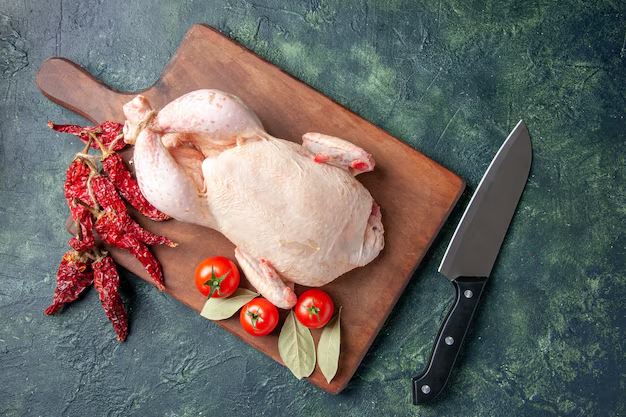Your Guide to Storing Chicken in the Refrigerator: How Long is it Safe?
Chicken is a staple in many households across the globe due to its versatility and nutritional benefits. However, like all foods, it comes with a shelf life that must be adhered to for both taste and safety. Have you ever stood in front of your open refrigerator, with that pack of chicken in hand, pondering whether it’s still good to use? If so, you're not alone. This article delves into the crucial aspects of storing chicken in the refrigerator, offering practical guidance on maintaining freshness and safety.
🕰️ How Long is Chicken Safe in the Refrigerator?
When it comes to the safety of refrigerated chicken, the consensus is that raw chicken remains safe in the refrigerator for approximately 1-2 days. On the other hand, cooked chicken tends to last longer, generally staying good for 3-4 days. It's vital to heed these timelines not only to enjoy the best taste but also to minimize the risk of foodborne illnesses.
Factors Influencing Chicken Shelf Life
Several factors can influence how long chicken will last in your refrigerator, including:
- Storage Temperature: Keeping your refrigerator at or below 40°F (4°C) is essential for slowing the growth of bacteria.
- Packaging: Airtight containers or original packaging that is properly sealed can help maintain freshness.
- Quality at Purchase: Chicken that is nearing its expiration date when purchased won't last as long as fresh chicken.
🔍 Recognizing Signs of Spoilage
Understanding spoilage signs is crucial. Trust your senses to identify if the chicken is no longer safe to consume:
- Smell: A sour or ammonia-like odor is a red flag.
- Color: Fresh chicken should be pink, not gray or greenish.
- Texture: If it feels sticky or slimy, it's time to discard it.
🍽️ Best Practices for Storing Chicken
Proper storage is key to extending the shelf life of chicken:
Storage Tips for Raw Chicken
- Immediate Refrigeration: Refrigerate chicken immediately after purchasing or thawing.
- Use Airtight Packaging: Store chicken in sealed plastic bags or containers to prevent air exposure.
- Bottom Shelf Storage: Place chicken on the bottom shelf to avoid cross-contamination.
Storage Practices for Cooked Chicken
- Prompt Cooling: Allow chicken to cool shortly after cooking before refrigerating.
- Separate Containers: Store different parts of cooked chicken separately if they were seasoned or cooked differently.
- Label & Date: Mark containers with the date to track freshness.
🥫 Deep Dive: Freezing Chicken for Extended Shelf Life
If you don’t plan to use your chicken within the recommended time frames, freezing is a great option. Here’s everything you need to know:
Freezing Raw Chicken
- Double Wrap: Use heavy-duty foil or freezer bags to prevent freezer burn.
- Portion Control: Divide into meal-sized portions before freezing.
- Label: Always mark the date and portion size for convenience.
Freezing Cooked Chicken
- Quick Freeze: Place in freezer immediately to maintain moisture.
- Frozen Life Span: Cooked chicken can last up to four months when properly frozen.
Thawing Frozen Chicken Safely
- Refrigerator Thawing: Plan ahead, as this method can take several hours but ensures safety.
- Cold Water Thawing: Submerge in cold water, changing water every 30 minutes.
- Avoid Room Temperature Thawing: This increases the risk of bacterial growth.
🛡️ Health Implications: Why Timely Chicken Storage Matters
Consuming chicken past its prime can lead to foodborne illnesses. The most common bacterial culprits include:
- Salmonella: Found commonly in raw poultry, it leads to symptoms like diarrhea and abdominal cramps.
- Campylobacter: Another bacterium found in raw chicken, causing similar digestive symptoms.
Cutting the Risks
To reduce the risks associated with these bacteria:
- Practice Good Hygiene: Always wash hands, surfaces, and utensils thoroughly after handling chicken.
- Cook to Proper Temperatures: Ensure chicken reaches an internal temperature of 165°F (74°C).
🔄 Sustainable Practices: Reducing Chicken Waste
Wasting chicken is not only economically inefficient but also has environmental repercussions. Here are ways to minimize waste:
- Meal Planning: Plan meals ahead to buy only what you need.
- Creative Left-overs: Use leftover chicken in soups, salads, or sandwiches.
- Composting: If disposal is unavoidable, consider composting the bones for garden mulch.
📜 Quick Overview: Refrigeration Do’s and Don’ts
Here is a quick summary for your refrigerator routine:
| Action | Recommendation |
|---|---|
| Refrigerating Raw Chicken | Store in bottom shelf, use within 1-2 days |
| Refrigerating Cooked Chicken | Use within 3-4 days, label dated containers |
| Freezing Chicken | Utilize sturdy freezer bags, portion appropriately |
| Identifying Spoilage | Check for off smells, discoloration, and sticky textures |
| Hygiene Practices | Maintain cleanliness, avoid cross-contamination, and cook thoroughly |
| Waste Reduction | Plan meals, repurpose leftovers, and compost the unavoidable |
By adhering to these guidelines, you’re not only ensuring food safety but also contributing to sustainable food consumption practices—a win-win for your kitchen and the environment.
Closing Insight: Ensuring Freshness and Safety
Proper storage of chicken maximizes both its shelf life and safety. By being conscious of the time frames and employing best storage practices, you not only enhance the quality of your meals but also protect your health. Implementing these practices and being mindful of chicken's life cycle in households can foster better food management. Remember, freshness and safety are paramount, and they start right in your refrigerator. Enjoy meals with the peace of mind that comes from proper food storage.
